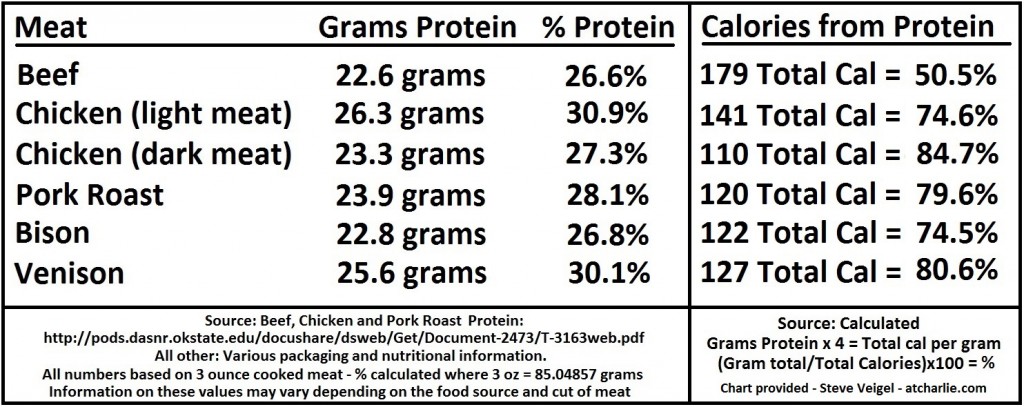Understanding Protein – How much your dog needs
Original article by S. Veigel September 7, 2015
Reviewed for relevancy 10/11/2020

I read where a dog should have 30% protein. I read where a dog should have 56% protein. And often the wolf is a feature depicting the need for higher protein levels or for feeding your dog nothing but meat. But then you have to ask the question. Don’t you? And that is, “Even if a wolf/dog needs 56% protein, what’s the other 44%?” If 100% of chicken breast is only 30.9% protein what’s the other 69.1% in the same meat?
Note: “Raw Dog Food Diets” are not just meat (muscle). You have to include more of the animal to get some of the other vitamins your dog needs. Like the liver where beef liver provides 24.7 grams protein and vitamins A, D and K. This article is only addressing meat protein.
This article speaks to protein for healthy dogs. The caveat here is that meat protein causes the body to produce ammonia which is normally filtered by the liver. If an animal has an aging or compromised liver it should have only the minimal amount of protein.
To help you understand this I compiled some information (shown above). To help you understand some of the arguments centered on the protein debates I think you should first understand 2 things. First, if you haven’t read “My dog is a carnivore” on this website, you really should. Second, I think you should have a basic understanding of what protein is and then I’ll try to put all this together.
Proteins are all different. In layman’s terms they are a group of amino acids and enzymes chained together. These chains that make up proteins serve many functions. Everything from DNA replication and the immune system to metabolism, hormones and of course building muscle. You also need to understand that there’s a difference between proteins we get from meat, meat bi-products and from vegetation. Strong complete chains are called “High quality” proteins (as with meat). Chains that are relatively less complete in the number of amino acids/enzymes or with weaker bonds are called “Low quality” proteins (like vegetation). But high or low you can compensate by adding amino acids and enzymes from other food sources. And, though their primary diet is meat, wolves/dogs will also do that.
When you think of meat you think “protein”. Maybe you think “pure protein”. But ½ of a skinless chicken breast weighing in at a little over 85 grams (3 ounce) is only about 26.3 grams of protein or 26.3 grams of amino acids and enzymes. If we calculate the percentage that chicken breast is about 30.9% protein. The other 69% before it’s even cooked or seasoned is 3.1 grams of fat, 99 milligrams of sodium, 74 milligrams of cholesterol, 218.12 milligrams of potassium, 1% calcium, 6% Iron, water, nitrogen and other potential components all bundled in a nerve responsive cellular structure we call muscle meat. Other meats also contain small amounts of naturally occurring sugars.
Note: It’s the natural sugar content that darkens or turns brown when the meat is cooked.
So on a primitive level when you crave protein it’s because your brain sees something it associates with a nice grouping of amino acids and enzymes to build your cells with. If you’re vegan (a vegetarian) you can’t just eat lettuce you add combinations of beans, brown rice and lentils and you might have drinks rich in amino acids to accomplish the same goal. But the bottom line is you’re not just eating or drinking a tasty substance, you’re reaching for amino acid chains with enzymes.
Because a meat protein is actually a quality form of amino acids and enzymes you don’t really have to worry about giving your dog too much protein. The body will take what it needs and expel the rest. Dogs need about 2 grams of protein per 1 kilogram or just over 2 pounds of weight (2.20462262185 pounds = 1 kilogram). That measurement of course should be applied to your dog’s “preferred weight” not how much your dog may be overweight and that recommendation is for the entire day, not every meal. To make this easier, just figure 1 gram per pound. So a dog (like a Beagle) that should weigh 25 pounds (depending on the type of Beagle) might need 25 grams of protein per day if it’s active and getting plenty of walks. Less if it’s not getting the exercise.
Still confused? Just think about it this way. That same 25 pound Beagle would need ½ of that ½ chicken breast per meal because it needs 25 grams of protein per day. The chicken breast has 26.3 grams of protein so it’s getting more than enough protein for the day. However, if you only feed that Beagle chicken breast you’re denying it essential vitamins, minerals and probiotics.
Percentage simplified – 30% or 56%
Sometimes the protein debate is confusing. When you’re done reading this go back and look at the chart provided above. Notice that cooked chicken breast is 30.9% protein. Then notice that the calories from protein for the same chicken breast are 74.6%. So the chicken breast is 30.9% actual protein content and 74.6% of all the calories in the chicken come from the protein content; because protein contributes calories. Then also note that Bison – something a wolf might eat – is only 26.8% protein. The calories from protein are 74.5%.
Dogs need between 20 and 35 percent meat based proteins (Bison 26.8% and chicken breast 30.9%). And, like I said, that protein provides a certain amount of calories. So when people say a dog should have 56% protein, though that may be true, they’re probably talking about the amount of calories from the protein, not the actual percent of protein in the meat.